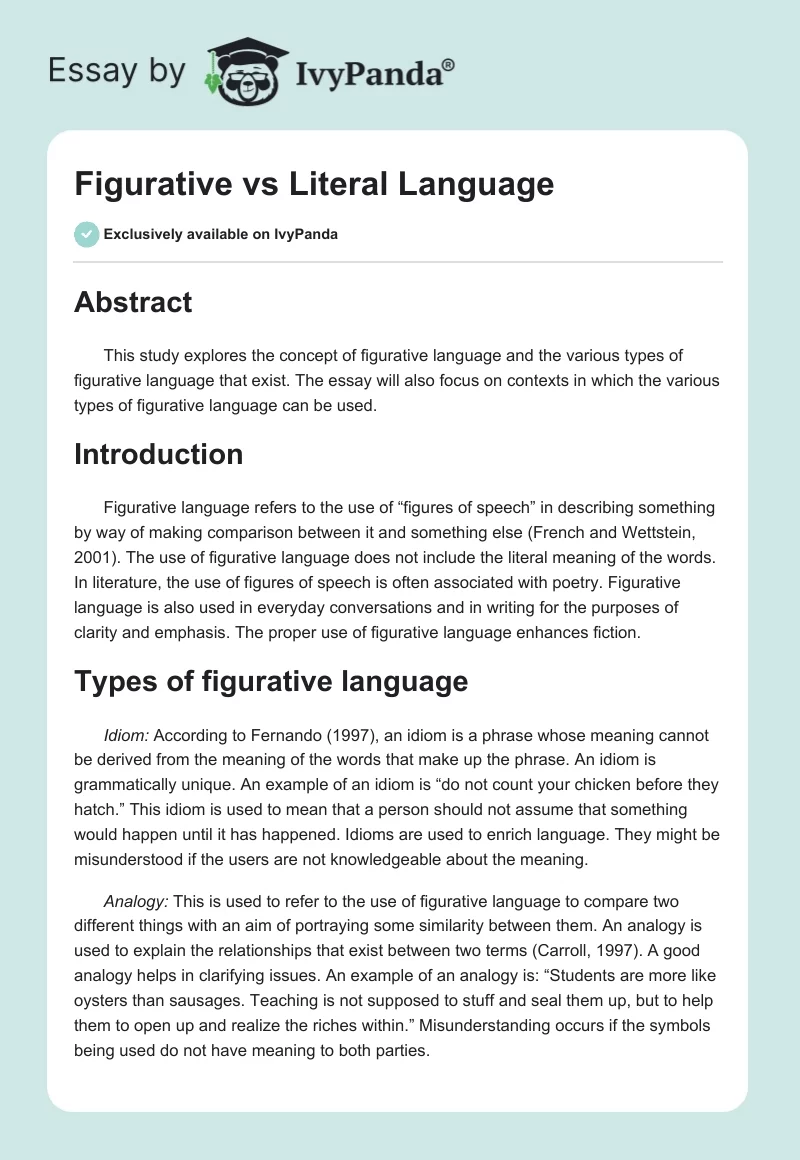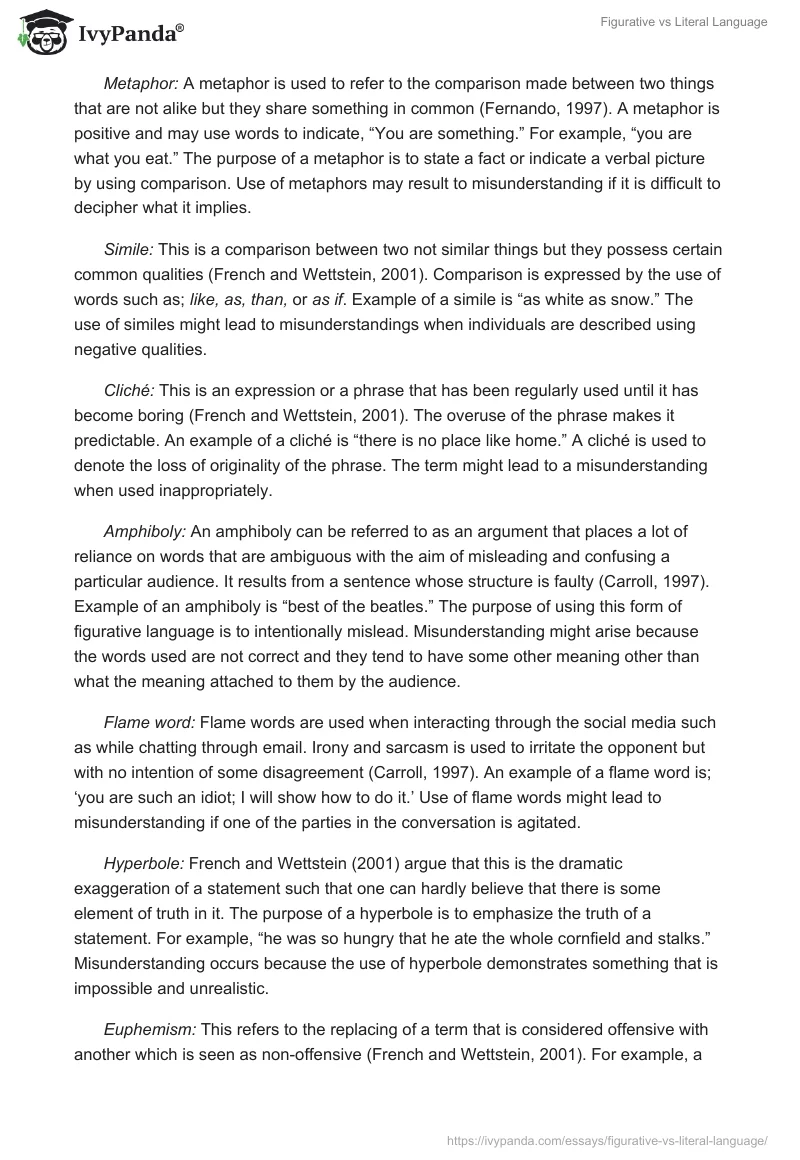Abstract
This study explores the concept of figurative language and the various types of figurative language that exist. The essay will also focus on contexts in which the various types of figurative language can be used.
Introduction
Figurative language refers to the use of “figures of speech” in describing something by way of making comparison between it and something else (French and Wettstein, 2001). The use of figurative language does not include the literal meaning of the words. In literature, the use of figures of speech is often associated with poetry. Figurative language is also used in everyday conversations and in writing for the purposes of clarity and emphasis. The proper use of figurative language enhances fiction.
Types of figurative language
Idiom: According to Fernando (1997), an idiom is a phrase whose meaning cannot be derived from the meaning of the words that make up the phrase. An idiom is grammatically unique. An example of an idiom is “do not count your chicken before they hatch.” This idiom is used to mean that a person should not assume that something would happen until it has happened. Idioms are used to enrich language. They might be misunderstood if the users are not knowledgeable about the meaning.
Analogy: This is used to refer to the use of figurative language to compare two different things with an aim of portraying some similarity between them. An analogy is used to explain the relationships that exist between two terms (Carroll, 1997). A good analogy helps in clarifying issues. An example of an analogy is: “Students are more like oysters than sausages. Teaching is not supposed to stuff and seal them up, but to help them to open up and realize the riches within.” Misunderstanding occurs if the symbols being used do not have meaning to both parties.
Metaphor: A metaphor is used to refer to the comparison made between two things that are not alike but they share something in common (Fernando, 1997). A metaphor is positive and may use words to indicate, “You are something.” For example, “you are what you eat.” The purpose of a metaphor is to state a fact or indicate a verbal picture by using comparison. Use of metaphors may result to misunderstanding if it is difficult to decipher what it implies.
Simile: This is a comparison between two not similar things but they possess certain common qualities (French and Wettstein, 2001). Comparison is expressed by the use of words such as; like, as, than, or as if. Example of a simile is “as white as snow.” The use of similes might lead to misunderstandings when individuals are described using negative qualities.
Cliché: This is an expression or a phrase that has been regularly used until it has become boring (French and Wettstein, 2001). The overuse of the phrase makes it predictable. An example of a cliché is “there is no place like home.” A cliché is used to denote the loss of originality of the phrase. The term might lead to a misunderstanding when used inappropriately.
Amphiboly: An amphiboly can be referred to as an argument that places a lot of reliance on words that are ambiguous with the aim of misleading and confusing a particular audience. It results from a sentence whose structure is faulty (Carroll, 1997). Example of an amphiboly is “best of the beatles.” The purpose of using this form of figurative language is to intentionally mislead. Misunderstanding might arise because the words used are not correct and they tend to have some other meaning other than what the meaning attached to them by the audience.
Flame word: Flame words are used when interacting through the social media such as while chatting through email. Irony and sarcasm is used to irritate the opponent but with no intention of some disagreement (Carroll, 1997). An example of a flame word is; ‘you are such an idiot; I will show how to do it.’ Use of flame words might lead to misunderstanding if one of the parties in the conversation is agitated.
Hyperbole: French and Wettstein (2001) argue that this is the dramatic exaggeration of a statement such that one can hardly believe that there is some element of truth in it. The purpose of a hyperbole is to emphasize the truth of a statement. For example, “he was so hungry that he ate the whole cornfield and stalks.” Misunderstanding occurs because the use of hyperbole demonstrates something that is impossible and unrealistic.
Euphemism: This refers to the replacing of a term that is considered offensive with another which is seen as non-offensive (French and Wettstein, 2001). For example, a word such as ‘died’ may be used in place of ‘passed away.’ Euphemism is used to substitute some words with others. Misunderstanding occurs when the new word used does not have similar meaning to the one it replaces.
Colloquialism: This statement is often used during conversations than while writing or making formal speeches. The use of colloquial statements is important because it gives people a sense of relaxation and freedom from using too formal language (Carroll, 1997). Colloquialism is limiting because the group that commonly uses them can only understand the statements. Example: ‘The MPs were described as ‘numpties’, this is a colloquialism meaning idiots.’
In conclusion, figurative language is widely used in conversations and in writing. The various forms of figurative language have particular meanings and they are used in varying circumstances. Misunderstandings may arise from the use of figurative speech especially when there is lack of shared meaning of the words that are used.
References
Carroll, D.W. (1997).Psychology of language. New York: Macmillan Publishers.
French, A.P, and Wettstein, K.H. (2001).Figurative Language.London: Blackwell publishers.
Fernando, C. (1997). Idioms and idiomacy.London: Oxford University Press.


